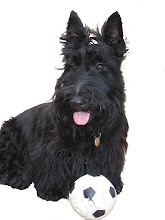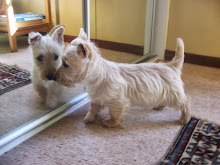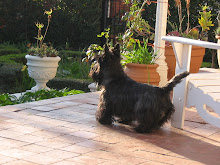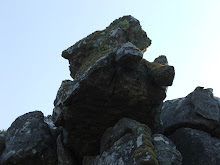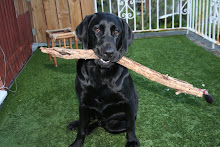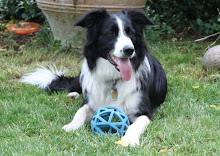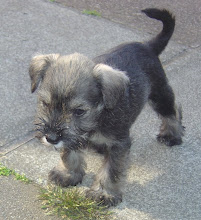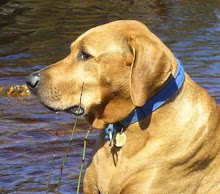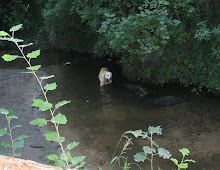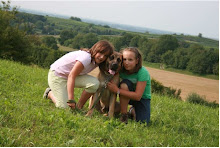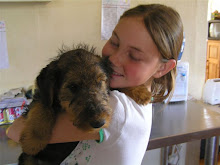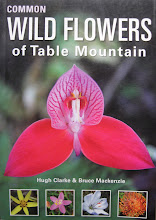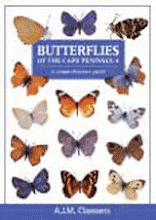
We were excluded from this little jaunt, but it sounds like it nearly did our two humans in, so we
concede that it was not really for us. And besides, it is part of the
Limietberg Nature Reserve that excludes all canines - but I would have loved to come and look for
bobbejaans to chase. Clare and
Roos came with our humans, and they met Anthea and Mike and
Bronwyn and four of her friends, Eleanor, John, Matthew and Jenna at
Bain's Kloof.

Looking back at
Bain's Kloof Pass. The
Bobbejaans River joins the
Witte which is the river that runs at the bottom of
Bains Kloof.

The FL specially got herself a waterproof camera so she wouldn't miss out on any special plant sighting, and this is
Erica pinea which is quite special as it only occurs in this area.

There was a lot of energetic jumping into the coolest of cool mountain pools. This is John.

Mike with all the
Westerfordians in a puddle, a huddle, a cuddle but not a muddle.

A very special first for the Food Lady - the Bush Lily,
Nivenia corymbosa. It also only grows in this area and nowhere else in the world.

Lunch and a little relax.

Another very cool looking pool and waterfall. The blue flowers of
Nivenia corymbosa cascading over the edge too.

There were also a few Red
Disas (
Disa uniflora).

Looking down the
Bobbejaans River.

A beautiful soft pink King
Protea (
Protea cynaroides).

The Food Lady playing with her new waterproof camera.
 Roos
Roos looking like a trapeze artiste. I would have loved to have a swim in that pool.

Clare and
Roos relieved that Mike is not going to make them jump or abseil down the next level far, far below.
The FL will put some more photos on
Facebook so check that out too.

The Mitre Aloe (
Aloe perfoliata).

Back to the start. Tired and hot and a bit sunburnt.
 Sue, Nola, Maverick and Goose, Paul and Pauline, our humans and us reported for duty at the stone gate at the bottom of Peck's Valley. This is Aristea dichotoma with Lachnaea grandiflora in the background.
Sue, Nola, Maverick and Goose, Paul and Pauline, our humans and us reported for duty at the stone gate at the bottom of Peck's Valley. This is Aristea dichotoma with Lachnaea grandiflora in the background.  Paul arrived with a beautiful Brownie Box camera.
Paul arrived with a beautiful Brownie Box camera.  We are all intrigued to see the results.
We are all intrigued to see the results. Us and the Alpha at the top of Pecks waiting for all the slowpoke photographing pholks to catch up. You can see the lovely cool mist in the background.
Us and the Alpha at the top of Pecks waiting for all the slowpoke photographing pholks to catch up. You can see the lovely cool mist in the background. Apologies to Maverick and Goose for lumping them in with Maltese Poodles in an earlier post. The Foodlady will amend the title forthwith. (Click here to check.) They are very distinguished terrier cross breeds. Just look at Goose's distinguished expression! And Dougal is trying to will the rusks to just JUMP out of the backpack.
Apologies to Maverick and Goose for lumping them in with Maltese Poodles in an earlier post. The Foodlady will amend the title forthwith. (Click here to check.) They are very distinguished terrier cross breeds. Just look at Goose's distinguished expression! And Dougal is trying to will the rusks to just JUMP out of the backpack. A misty but not too chilly tea in the rocks. Nola, Maverick, Goose, us two, Sue, Paul, Pauline and the Alpha Male.
A misty but not too chilly tea in the rocks. Nola, Maverick, Goose, us two, Sue, Paul, Pauline and the Alpha Male. Paul shooting from the hip.
Paul shooting from the hip. Crassula coccinea - a very very red Red Crassula (almost as red as Paul's boots!) that is also pollinated by the Table Mountain Pride butterfly. According to PlantZafrica,the botanist, Rudolph Marloth explains in his description of Crassula coccinea published in Flora of South Africa (1913-1932) that 'this dazzling brightness ... is principally due to the dome-shaped form of the epidermal cells, each acting like a combination of a convex lens with a concave reflector'.
Crassula coccinea - a very very red Red Crassula (almost as red as Paul's boots!) that is also pollinated by the Table Mountain Pride butterfly. According to PlantZafrica,the botanist, Rudolph Marloth explains in his description of Crassula coccinea published in Flora of South Africa (1913-1932) that 'this dazzling brightness ... is principally due to the dome-shaped form of the epidermal cells, each acting like a combination of a convex lens with a concave reflector'.




 They had a tea stop at the top of Window Gorge in among lots of flowering red
They had a tea stop at the top of Window Gorge in among lots of flowering red 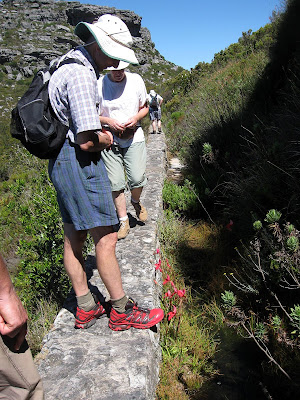 They then walked on to the
They then walked on to the  En route to the top of Nursery Ravine, this little clump of firs, silver birches and oaks and some ruined mossy stone walls are all that's left of the
En route to the top of Nursery Ravine, this little clump of firs, silver birches and oaks and some ruined mossy stone walls are all that's left of the 





















 Tea on the rocks overlooking Hout Bay beach. Thea, Sue (trying to beat the Food Lady at her own game), The Alpha, Kristin, Richard, Nola and standing on the rock looking goofy is Dawniedawg. You can just see my tail - up.
Tea on the rocks overlooking Hout Bay beach. Thea, Sue (trying to beat the Food Lady at her own game), The Alpha, Kristin, Richard, Nola and standing on the rock looking goofy is Dawniedawg. You can just see my tail - up. 

















